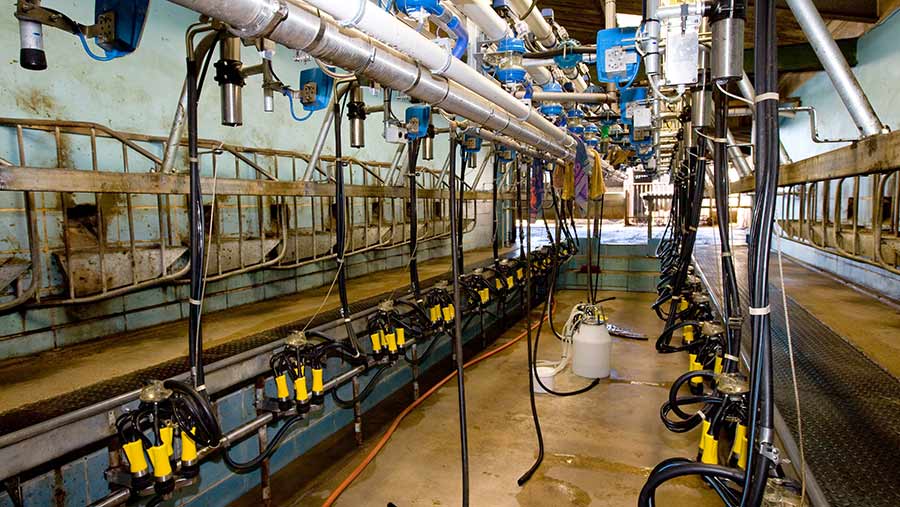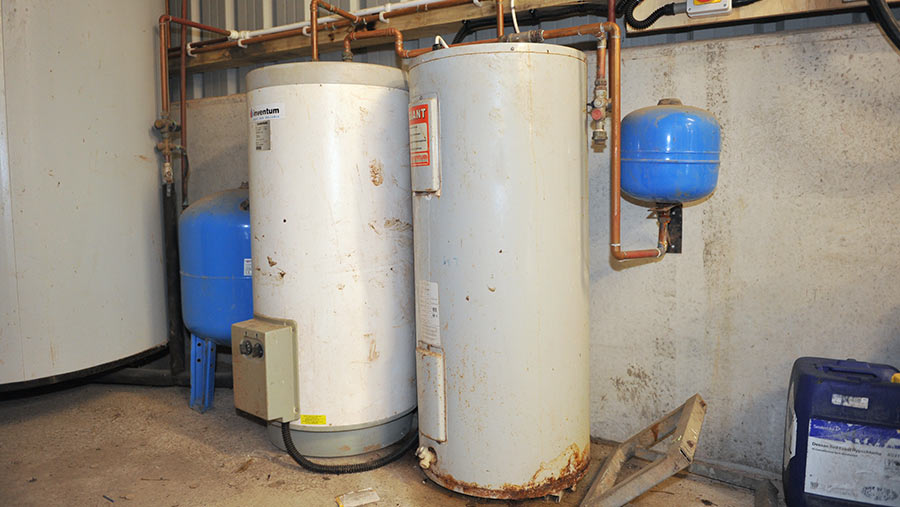Guide to water heating options for your dairy parlour
 The parlour should have sufficient hot water for at least one milking © Tim Scrivener
The parlour should have sufficient hot water for at least one milking © Tim Scrivener Heating water accounts for 23% of the energy costs on a typical dairy farm, meaning savings can quickly be made by operating the most efficient system.
Despite electricity being the most expensive energy source it is still the most common method of powering water heating systems on UK dairy farms, says David Ball, environment and buildings senior manager at AHDB Dairy.
Every dairy has an electricity supply, so it can often be the simplest solution, he says.
Other systems are cheaper to run – a solar thermal system has virtually no running costs – but there is the capital investment to consider.
Farmers Weekly looks at the pros and cons of different energy sources for heating water in milking parlours.
Electricity
Average figures suggest that a dairy cow uses 350 kilowatt hours (kWh) of electricity a year, of which 40% is for heating water.
The most common approach with electric boilers is to use night-rate electricity in combination with an immersion heater. As the night rate is often half the day rate, it is beneficial to operate electrical water heating systems entirely using the cheaper tariff, provided water tanks are well insulated, says Mr Ball. He advises synchronising the water heater with the night rate.
“Connect the water heater to a timer to ensure water is not heated unnecessarily and, where possible, heat all the water you need for the day using cheap-rate electricity,’’ he says.
This might involve buying a second heater to avoid using daytime electricity, but the capital outlay should be recouped quickly through the energy cost savings, he adds.
Pros
- Easy to install.
- Low maintenance.
- A farm generator often covers power supply interruptions.
Cons
- Electricity is one of the fastest rising costs in dairy farm operations, and upward pressure is likely to continue for the foreseeable future.
Considerations
If you are using an electric heating system in a hard water supply area, take steps to keep the element free of lime deposits.
Gas
Some gas boilers can deliver 70 litres of hot water at 80C in seven minutes, depending on the farm’s water pressure.
Pros
- Provides a reliable and consistent supply.
- Hot water is available at the flick of a switch. Unlike other systems, there is no waiting time associated with heating water.
- No hot water storage facilities are needed, meaning gas doesn’t have the standby energy losses associated with storage water heaters.
Cons
- The UK is not self-sufficient in gas so prices are affected by demand around the world.
Considerations
- If mains natural gas is not available a separate storage tank will be required.
Oil
Oil-fired water heating systems can provide large volumes of hot water very quickly, although the maintenance requirements and capital costs can be higher than those of electric systems.
Pros
- Oil is a highly efficient fuel, and so produces a good return on every unit of energy.
- Use not restricted by night-rate electricity.
Cons
- A separate boiler and fuel store are required.
- Depending on the model, standby losses can vary from about 1% an hour to more than 3%.
- The price of oil can fluctuate, with sudden spikes caused by surges in demand, weather conditions and geopolitical factors.
- As oil is delivered by road, there is a possibility that supply could be interrupted, especially in winter weather conditions.
Considerations
- Oil is cheaper than daytime electricity, with costs similar to cheap rate electricity.
Heat recovery unit
Cooling milk releases heat that is normally evacuated into the air by the condenser of the refrigeration unit.
The refrigerant leaving the compressor of a milk cooling system is at 21-27C – energy that can be used to pre-heat water before it enters a water heater. A heat recovery unit (HRU) transfers this energy from the refrigerant to water in a storage tank, raising the water temperature.
The most common type is essentially a large, insulated water tank that recovers heat from the refrigerant whenever the compressors run. The water heater is filled from the HRU, which in turn is fed by cold water from either the mains or a borehole. An HRU can pre-heat the water to 45-60C.
One of the key factors influencing the efficiency of an HRU is whether a mains water plate heat exchanger is used with the milk cooler. This reduces the amount of refrigeration-based cooling required and, therefore, means there is less heat to recover.
Pros
- A litre of milk cooled from 35C to 4C can heat a litre of water to 50C.
- Can be retrofitted to existing installations.
- Can provide a more pleasant working environment by reducing the “sauna effect” produced by the refrigeration condensers.
Cons
- Supplementary heating of heat-recovery water by electricity or oil is always required to achieve the desired temperature of 80C.
- A second tank to heat the water to 80C is required – the heat recovery tank should be used as a buffer tank only, to pre-feed the final temperature tank.
- Many older cooling systems still operate on the old R12 refrigerant or similar, which is now no longer available. Upgrading an old system to heat recovery will involve converting it to operate on new 404A refrigerant, which can be expensive.
Considerations
- Installing an HRU is a specialised job and should be done by a registered refrigeration technician with experience of heat recovery equipment.
- Incorrect installation will stress the compressors and drive higher power consumption as well as decreasing compressor life.
- Installation by anyone other than the original manufacturer/commissioner of the system will almost certainly void the warranty.
- A guarantee should be sought for all heat recovery installations.
Solar thermal
A solar hot water system has the following main components: collectors, which absorb as much heat as possible from the sun’s radiation; a heat transfer system made up of insulated pipework containing the heat transfer fluid; a water pump; a heat exchange system; measurement equipment and a control system; and a water storage vessel.

To make best use of cheap rate electricity a second heater may be needed
The most common system is a pressurised indirect primary circuit – the hot water from the solar collectors is pumped through a heat exchanger in the boiler to pre-heat the water.
Lower-cost options are available and include thermo-siphon systems, which integrate the collector with the storage tank.
Pros
- Solar heating systems have a long life with low maintenance – many work reliably for at least 20 to 25 years.
- On sites with high hot water demand, such as dairies, the system can pay for itself two or three times over during its working life.
- Solar heating is a sustainable source of energy that is clean and efficient.
- Attracts the Renewable Heat Incentive (RHI) payment system.
Cons
- The initial capital outlay is higher than that for other systems.
Considerations
- A solar thermal system normally connects into any existing setup, taking most of the energy load from an immersion heater.
Five key considerations when replacing your old water heater
- Water storage tank should be sized to provide enough hot water for one milking as a minimum, according to the number of cows being milked – British Standards require a minimum of 18 litres of boiler capacity per milking unit, irrespective of the method of cleaning used
- Farm energy costs should be calculated before selecting a heating method
- Look for a system with a high Energy Factor rating
- Weigh up the price of the heater against the annual running costs
- Test water for hardness – a water softener should be installed in hard water areas
Top tips for running hot water heaters
- Ensure time clocks are set correctly.
- Check the thermostat setting.
- Check for leaks.
- Insulate your water heater – a well-insulated heater will lose less than 5% of its heat compared with 50% from water stored in a bare copper cylinder.
- Insulate the first six metres of pipe running from the heater.
- Purge 9-14 litres from the water heater’s drain tank twice a year.
- Avoid heating to too high a temperature – 80C is adequate.
